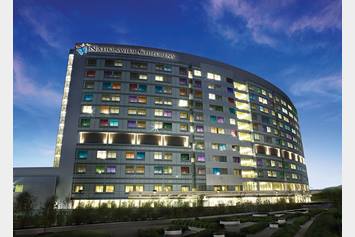Shoulder Injuries
Shoulder injuries in children are common and can happen from falls, sports, or overuse, but most heal well with rest and proper care.
The shoulder is made up of 3 bones: the shoulder blade (scapula), the upper arm bone (humerus), and the collarbone (clavicle). The head (top) of the humerus fits into a small socket in the scapula called the glenoid. A soft rim of tissue, called the labrum, lines the socket and helps keep the shoulder steady. If the labrum tears, the shoulder can feel loose or unstable. This injury often requires surgery to repair and stabilize the shoulder.
Another important part of the shoulder is the rotator cuff. It is a group of muscles and tendons that connect the humerus to the scapula. The rotator cuff helps your child lift their arm and reach overhead. When hurt, the shoulder can feel weak, stiff, or sore.
Next Steps
What Are Common Causes of Shoulder Injuries?
- Falling onto an outstretched arm
- Direct impact to the shoulder
- Dislocating the shoulder
- Overuse
- Repeated overhead movements
What Are Common Symptoms of Shoulder Injuries?
Labral Tears
- Decreased range of motion
- Feels unstable or like the shoulder could "pop out"
- Feel or hear sounds of clicking, grinding, locking, or popping
- Pain when lifting an object overhead or throwing
Rotator Cuff Tears
- Pain with overhead movements
- Pain that goes down the arm
- Pain at night, especially when sleeping on the side of the injured shoulder
How Can Shoulder Injuries Be Treated?
Shoulder injury treatments may include:
- Rest and ice on the injured area.
- Medicines to relieve pain. You can switch between (alternate) these medicines:
- Ibuprofen (Motrin®): Helps reduce pain and swelling. Take every 6 hours.
- Acetaminophen (Tylenol®): Helps with discomfort. Take every 6 hours.
- Physical therapy to help basic shoulder motion and improve strength.
- Surgery if other treatments do not work.
Surgery
Surgery is often done arthroscopically through small cuts (incisions) to look at the shoulder using a tiny camera. Some tears may be fixed with small stitches. If the tears are too small to fix, your child’s surgeon will clean out (debride) the frayed tissue.
After Surgery
- Sling – If your child’s labrum is repaired, they will wear an UltraSling®. It’s very important to keep the sling in place, except when showering. While showering, make sure your child does not move or use the injured shoulder. The sling helps the shoulder heal the right way, so your child must wear it as recommended.
- Driving – If your child is wearing an UltraSling, they cannot drive until their doctor or health care provider removes it. This is usually about 6 to 8 weeks after surgery. Before driving again, your child must have full movement and control of their shoulder.
- Pain medicine – Your child will get a prescription for pain medicine. The surgeon may also recommend ibuprofen (Motrin®) to help with pain and swelling. Taking Motrin can also help your child stop using prescription pain medicine sooner.
- Exercises – At the first follow-up appointment after surgery, your child will be referred to physical therapy. The therapist will teach special exercises to strengthen the shoulder and improve movement as it heals.
When Should I Get Help for an Injured Shoulder?
Call your child's doctor or health care provider if they have:
- Pain not controlled by oral medicine
- Drainage from the incision
- Fever of OR higher than 101° Fahrenheit (F) or 38.3° Celsius (C) by mouth
- A new rash
- Chills
- Nausea or throwing up (vomiting)
Follow-up and Recovery
- Your child’s first follow-up will be about 7 to 10 days after surgery. At this visit:
- Their incisions will be checked to make sure they’re healing well.
- The stitches on the outside of the shoulder will be removed.
- You can talk with the care team about how your child’s pain is being managed.
- It usually takes about 5 to 6 months before your child can go back to normal sports or activities. During this time:
- Their doctor or health care provider and physical therapist will help your child slowly build shoulder strength and movement.
- Your child’s physical therapist will follow the timeline for your child’s care plan for recovery and activity levels.
- It’s very important that your child does not return to sports or other activities until the doctor or therapist says it’s safe.
- Following these steps will help your child’s shoulder fully heal.
Helping Hands™ Patient Education Materials
Helping Hands™ are easy-to-read guides about different illnesses, therapies, surgeries, and more. They’re created by the Patient Education team at Nationwide Children’s Hospital and are reviewed and approved by clinical staff, like nurses, doctors, pharmacists, and psychologists. Nationwide Children's Hospital is not responsible for misuse of information in patient education materials, including Helping Hands.
HH-I-437 | ©2018, revised 2025, Nationwide Children’s Hospital



